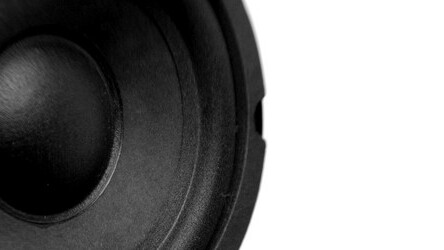
Chances are, if you or your business is using social media to reach out and interact with consumers, you’ve either already got content on YouTube, Vimeo, etc., or are seriously contemplating it. Whether it’s a 1,2,3, one stop production house like animoto.com, or something a bit more in depth, video is where it’s at, and if you’re not there already – what are you waiting for?
Don’t just take my word for it. Market research firm eMarketer recently published an outlook that will see spending on online video advertising grow more than 48% this year alone, reaching a cool $1.5 billion. By 2014, eMarketer is projecting numbers in the $5.5 billion ballpark.
And while I’ve seen a number of outstanding tutorials on how to write a killer script, when and where to deliver your message, I’m hard pressed to find a decent outline regarding the production of crystal clear audio behind your video. Let’s face it…your production could be all the eye candy you could ever imagine, but if the audio isn’t up to par, who’s going to watch it?
The science of microphones

First, it’s important to recognize that there are a wide variety of microphones suitable for audio for video. We’ll focus on two: Condenser microphones and Dynamic microphones.
Condenser microphones are those large mics you see in every radio broadcasting and sound recording booth. One of the primary differences between condenser mics and dynamics mics is that condensers require an external power source (phantom power) in order to properly function. I won’t get into the physics behind it, but just know this: Condenser mics are more suited for a studio environment. They require external power, don’t like to be moved very much, and are generally quite temperamental. With that said, in a studio environment, their sound capturing qualities can’t be beat. If you’re doing a screencast, slideshow, or any other vocal work where the speaker will not be seen, a condenser mic is the way to go.
Dynamic microphones on the other hand are the ones that you’re most probably familiar with. If you’ve ever made an announcement over a PA, or been to a live music event, I guarantee you’ve been watching a dynamic mic at work. Because of the way dynamic mics function (electromagnetic induction), they do not require an external power source, are highly resistant to moisture (heavy breathing?), and can be acquired for a relatively low cost when compared to condenser mics. If you’re going to be featuring an on camera speaker, a dynamic mic should be your weapon of choice.
Connections
 It’s worth noting that many mics connect to their corresponding audio cable via an XLR connection. Basically you’re looking at a +/- connection with a ground. If the camera you’re shooting on includes XLR inputs, by all means, plug in and go forth. However, as these types of inputs are generally reserved for high-end cameras, chances are you’re looking at a mini-jack input for your microphone. If your camera doesn’t have a mic input, you’ll have to use the handy recorder method mentioned below. If your camera does have a mic input, chances are it’s a mini-jack input, so you’ll need an XLR to Mini conversion cable (~$5). Likewise, any microphone can be presented as a wireless mic, but for the sake of simplicity and low cost, let’s focus only on wired mics.
It’s worth noting that many mics connect to their corresponding audio cable via an XLR connection. Basically you’re looking at a +/- connection with a ground. If the camera you’re shooting on includes XLR inputs, by all means, plug in and go forth. However, as these types of inputs are generally reserved for high-end cameras, chances are you’re looking at a mini-jack input for your microphone. If your camera doesn’t have a mic input, you’ll have to use the handy recorder method mentioned below. If your camera does have a mic input, chances are it’s a mini-jack input, so you’ll need an XLR to Mini conversion cable (~$5). Likewise, any microphone can be presented as a wireless mic, but for the sake of simplicity and low cost, let’s focus only on wired mics.
Types of microphones
But what about my on camera audio, you say? Fair enough. If you’re planning on producing a video where the speaker is no more than 3-4 feet maximum away from the camera, you’ll get decent audio. But what if your subject is more than 4 feet away? Perhaps demonstrating a product, or better yet, what if you’re doing an interview? What if there’s noise happening to the sides of, and behind the lens? Here are four unique audio capture methods that can be used to vastly improve your audio for video.
Handy Recorder
 It may have it’s roots in the cliché, “Note to self,” but today’s pocket recorders are nothing like that pocket tape deck pops was using. Driven by audio enthusiasts, DSLR filmmakers, and perhaps a bootlegger or two, a handy recorder can be an excellent solution what it comes to getting great audio for your video. They come in all sizes and flavors, and I personally use a Zoom H2 which I picked up on eBay for $85. It offers a wide range of audio recording formats, as well as microphone pickup patterns, and can be used just about anywhere. As audio options for DSLR shooters are a bit limited, I’ve seen more than a few of these lined up on a panel table at a conference. Likewise, when clamped on to the end of a microphone stand, you can get great audio when holding one of these just above or below a speaker’s head off camera.
It may have it’s roots in the cliché, “Note to self,” but today’s pocket recorders are nothing like that pocket tape deck pops was using. Driven by audio enthusiasts, DSLR filmmakers, and perhaps a bootlegger or two, a handy recorder can be an excellent solution what it comes to getting great audio for your video. They come in all sizes and flavors, and I personally use a Zoom H2 which I picked up on eBay for $85. It offers a wide range of audio recording formats, as well as microphone pickup patterns, and can be used just about anywhere. As audio options for DSLR shooters are a bit limited, I’ve seen more than a few of these lined up on a panel table at a conference. Likewise, when clamped on to the end of a microphone stand, you can get great audio when holding one of these just above or below a speaker’s head off camera.
Bonus tip: If you’re recording audio/video at an event that’s being broadcast via a PA, seek out the audio engineer, and see if you can’t tap into the main mixing board feed for optimal audio.
Handheld mic
If you’re shooting video featuring a speaker (or two), a handheld, dynamic mic is a great way to instantly improve your audio. Not only does it bring your audio infinitely closer, but it can also give a nervous presenter something to hold on to; an anchor, if you will. The Shure SM58 is older than the sun, moderately priced, and I’m pretty convinced they’re made from some super rare asteroid metal, as these mics are virtually indestructible. SM58 or not, in a handheld mic, you’ll be looking for one featuring a cardioid pattern.
Avoiding the rocket science here, a cardioid pattern looks much like it sounds; heart shaped. It will pick up the signal being placed directly in front of it, and avoid sounds behind it. This is one of the key components of better audio for your videos, as we’re focusing only on you, and eliminating as much of the background noise as possible.
Shotgun mic
 No, this has nothing to do with a wedding, or duck season. A shotgun mic is one of the most common mics used in professional television and film production. Remember seeing the blooper reel, or the shot of the shot, whereby some guy or gal is standing off-screen with a pair of massive headphones and holding something on a stick above everyone’s heads? Technically, that’s a boom operator that you’ve seen, and they’re in charge of operating a shotgun mic above the actors’ head. This type of microphone is very popular in this setting due to it’s highly directional pickup pattern. Just as the name states, a shotgun mic can literally be aimed at a sound source, and zeroed in. This microphone focuses primarily what is directly in front of it (at a distance), canceling out side and rear sound. On my Canon Vixia HF10, I use the DM-100 shotgun mic, while Rode’s VideoMic makes an excellent shotgun mic specifically designed for DSLR shooters.
No, this has nothing to do with a wedding, or duck season. A shotgun mic is one of the most common mics used in professional television and film production. Remember seeing the blooper reel, or the shot of the shot, whereby some guy or gal is standing off-screen with a pair of massive headphones and holding something on a stick above everyone’s heads? Technically, that’s a boom operator that you’ve seen, and they’re in charge of operating a shotgun mic above the actors’ head. This type of microphone is very popular in this setting due to it’s highly directional pickup pattern. Just as the name states, a shotgun mic can literally be aimed at a sound source, and zeroed in. This microphone focuses primarily what is directly in front of it (at a distance), canceling out side and rear sound. On my Canon Vixia HF10, I use the DM-100 shotgun mic, while Rode’s VideoMic makes an excellent shotgun mic specifically designed for DSLR shooters.
For your production, I’m going to go out on a limb here and say that you probably don’t have your own boom operator handy, so if you’d like to go the shotgun route, make sure that your camera has a mount for it. Alternatively, I’ve been known to go ultra-low budget, break out the duct tape and a broom handle, and the final viewer was none the wiser. Antics like this are pure gold when it comes to the b-reel.
Lavalier mic
 A lavalier mic is a special mic designed for hands free use. Lav mics are my personal favorite, as they allow you to get your microphone the closest to the sound source, all the while, barely being seen. If you’ve been to a conference within that past 20 years, I guarantee you’ve seen/heard a lavalier mic. Also known as the tie-clip mic, this little gem allows you to put a tiny microphone just below your presenter’s mouth, resulting in the most dynamic sound from a distance.
A lavalier mic is a special mic designed for hands free use. Lav mics are my personal favorite, as they allow you to get your microphone the closest to the sound source, all the while, barely being seen. If you’ve been to a conference within that past 20 years, I guarantee you’ve seen/heard a lavalier mic. Also known as the tie-clip mic, this little gem allows you to put a tiny microphone just below your presenter’s mouth, resulting in the most dynamic sound from a distance.
Given their “hands free” nature, a large number of lavalier mics are available in wireless combinations. It’s also worth noting that lavalier mics are condenser mics, which mean they require an external power source to function. Therefor, not only do the wireless transmitters sound a sound signal to the receiver, they also provide battery power for the microphone itself. Now, if you just jumped over to Amazon and your jaw hit the floor when you saw what a wireless lavalier mic costs, fret not…there are more affordable solutions.
If you’re doing a product demonstration, a talk, an interview, etc. where you know you’re not going to be doing a lot of moving about, a wired lavalier mic solution can arrive at your door for under $40. I personally use and love Audio Technica’s ATR 3350’s. I have a pair of them and consistently use them for video interviews.
kHz and Bits

Now that you’ve reviewed and selected the idea mic for your production, it’s time to get some sound in the ears. But hold up there chief…what’s your format? If the camera you’re shooting with has an external microphone input, carry on, as your sound will most certainly line up with the video. But what if you’re not so lucky, and still want great audio? This is where the handy recorder comes in.
Since we’re trying to accomplish as high quality audio as possible, first and foremost, make sure that you’re recording audio in an uncompressed format (.wav). This audio will be compressed later on, so why not start with as high quality a source as possible? But isn’t mp3 quality good enough? Yes and no. For a final output to YouTube, mp3 quality is perfectly acceptable. Remember, mp3 is merely an encoding format for a lossy audio compression algorithm. If you’re recording video and audio for a 1+ hr. long presentation, ok, I’ll cut you some slack here, but get a bigger memory card next time.
Regardless of which format you choose to use, there is one key setting that you absolutely must not overlook: Sample Rate. The audio sample rate refers to the number of times a sample of a constant sound source is taken over a unit of time. This audio sample rate must match the sample rate settings of your video project. The most common mistake is recording audio in 44.1kHz, a standard audio CD sample rate, and trying to match it to a 48kHz recorded video. When you do this, your audio track and video track will begin to slip out of sync, gradually becoming further and further apart over time.
If you’re shooting in HD, chances are you’re working with AVCHD, or .mt2s files, which by default record audio in AC3 format, which in turn defaults to a 48kHz sampling rate. Try saying that 3 times fast. To simplify – 9 times out of 10, you can’t go wrong with 48kHz/16 bit on for your audio settings. And if you happen to be that 1 out of 10 chance where your camera records audio in 44.1kHz, remember, you can always down sample audio, but never up sample.
Slate it

When it comes time to synchronize your superior externally recorded audio, you’ll need a cue to line it all up. Other than scene information, time code, and color references, one of the most important factors in any professional video production is the digital slate. Amongst the variety of reference points this provides to film makers, the audio engineer depends on that classic, “Clap ….and…action”. In your very own “post production” you can use this clap sound and video footage to perfectly synchronize the two.
By applying any one of these simple audio procedures, the difference between on camera audio, and using an external sound source, or microphone, should be as clear as day and night. And whether they know it or not, your viewers will appreciate that you went the extra mile to ensure that they could not only see what you have to say, but hear it as well.
Also read: Gobbler: A service for backing up, sending & organizing audio
Get the TNW newsletter
Get the most important tech news in your inbox each week.




